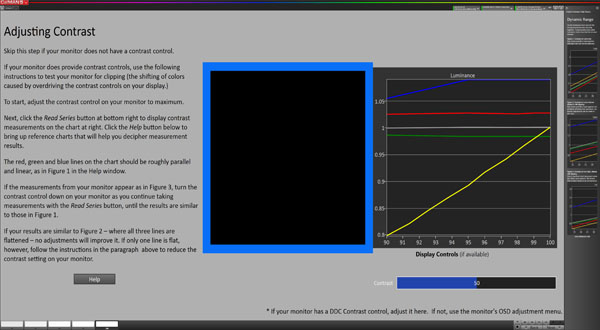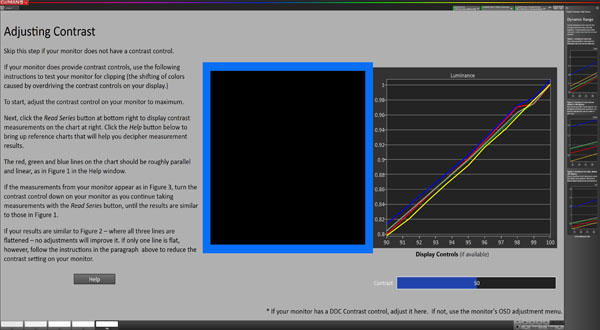Do It Like Tom's: Calibrating Your Monitor With CalMAN RGB
A while back, we introduced you to display calibration with Datacolor's Sypder4Elite. Today we look at CalMAN RGB, which is the other major calibration solution. With extensive meter and pattern source support, it’s positioned as a professional’s tool.
CalMAN RGB How-To: Advanced Calibration, Part 2
Now we’re into the meat of the calibration. The meter window is always at the center of the screen, as you see below. This lets you set your instrument in place for the duration. If you use an i1Pro, you’ll have to re-initialize it every 10 minutes, while the i1Pro2 and C6 meters don’t have that requirement. We used the C6 for the rest of our testing.
This is our Dell UP3214Q in its Standard picture mode. It’s pretty close to the mark, but there is room for improvement, especially in the color gamut. On the left is a grayscale trace showing a slight blue tint to the image. An average error of 3.85 Delta E is tolerable, but we want to get under one as we always do! The color checker is something we don’t typically use in reviews. However, it’s a practical measurement of color. Rather than primary and secondary color saturations, the color checker measures recognizable shades like grass, sky, and flesh. When you’re able to create a LUT, it’s possible to adjust for these colors. Of course, with a traditional CMS, you need to measure primary and secondary colors to hone the results.
Next up is the Contrast adjustment.
This is pretty cool way to adjust Contrast. When we do it for a monitor review, we use patterns that show clipping points for white and the three primary colors. We also measure a 100-percent brightness pattern to fine-tune the setting. CalMAN's screen does pretty much the same thing. It measures patterns from 90 to 100 percent so you can see if any color clips. You’ll need several runs to get it right, but the process doesn’t take long. Since Dell's UP3214Q connects with CalMAN’s DDC control, the slider on the lower-right will change the Contrast setting in the OSD.
The following image is what you want to see.
When all three primaries form a straight line, you have your Contrast set correctly. Unlike Brightness, Contrast has only one ideal setting. Brightness controls the backlight so you should always use that to control light output.
Setting Brightness is even easier.
Get Tom's Hardware's best news and in-depth reviews, straight to your inbox.
All you have to do is type your desired maximum output number into the dialog box. Then click the AutoCal button at the bottom-right. CalMAN flashes patterns and adjusts your Brightness control until the target is reached. If your monitor doesn’t support DDC, use the OSD to set it manually.
On the next page, we move on to grayscale calibration.
Current page: CalMAN RGB How-To: Advanced Calibration, Part 2
Prev Page CalMAN RGB How-To: Advanced Calibration, Part 1 Next Page CalMAN RGB How-To: Advanced Calibration, Part 3
Christian Eberle is a Contributing Editor for Tom's Hardware US. He's a veteran reviewer of A/V equipment, specializing in monitors. Christian began his obsession with tech when he built his first PC in 1991, a 286 running DOS 3.0 at a blazing 12MHz. In 2006, he undertook training from the Imaging Science Foundation in video calibration and testing and thus started a passion for precise imaging that persists to this day. He is also a professional musician with a degree from the New England Conservatory as a classical bassoonist which he used to good effect as a performer with the West Point Army Band from 1987 to 2013. He enjoys watching movies and listening to high-end audio in his custom-built home theater and can be seen riding trails near his home on a race-ready ICE VTX recumbent trike. Christian enjoys the endless summer in Florida where he lives with his wife and Chihuahua and plays with orchestras around the state.
-
merikafyeah I know it's exaggerated for the purpose of demonstrating differences in calibrated views, but you have got to pick a better "before and after" pic than the one you've been using up to now. They don't even compare the same subject. Half of the image is one thing and the other half is something else entirely. It's impossible to compare something if you're not even certain what exactly it is that you're comparing. I'd argue they don't even depict the kind of differences you'd see in calibrated vs uncalibrated displays, just different preferences in regards to artistic color-grading.Reply -
daglesj Are the Datacolor Spyders now properly calibrated out of the factory? Apparently quality control and specs were not very well handled with the Mk3 and befores. Basically every Spyder 3 would give different results.Reply -
sveinan I would recommend a review on ColorHUG (about $110), open source display colorimeter. It's fast, and worth it's money (http://www.hughski.com/index.html).Reply -
MANOFKRYPTONAK CNET reviews TVs and they post their calibration settings that they use for the best results. Each calibration is set up with professional tools, you can look up each tv by model number. I don't know if it is as good as this but.. its free! And it made a difference for me. But others like colorHUG, displaycalGUI, etc... are good just some different options if anyone is looking.Reply -
cangelini ReplyHate to say it, but this one reads like an infomercial....
This is simply the follow-up to an earlier story we did on Datacolor's solution that was well-received: http://www.tomshardware.com/reviews/spyder4-monitor-calibration-image-quality,3581.html. Both tools are in-use in our labs--I think it's useful to show our readers what we use to review monitors and how they might achieve similar results. At least, that was the intent. -
Evolution2001 I'd really like to calibrate my projector using more than just my eyes for perception. Using either the Spyder or CalMAN solutions, which ones offers me the least expensive path to that goal? Is it better to buy one of their all-inclusive packages, or find a colorimeter and software independently?Reply



